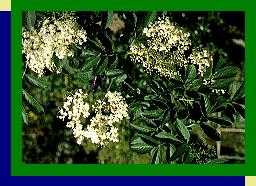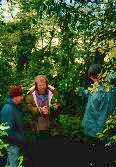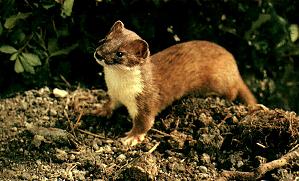
Pest control
Queen Elizabeth II
National Trust
Enhancing your Covenant Area
|
|
|
Plant Pests. A weed is a plant in the wrong place! Controlling this problem is hard work, but being aware of the 'weeds' and not unknowingly increasing their presence is a start. |
For control work on more woody plants with stems of 1cm - 10cm diameter cutting these off using loppers/secauters/saw, and painting with Vigilant gel, preferably in the growing season (November - March), should have good results. For plants like holly and elderberry, cut-off material needs to be removed as it is likely to root and grow again. The plants more often identified as weeds, gorse, broom and blackberry, are often not a serious threat to forests. Gorse and broom can act as a nurse crop and in time natives will grow up through them. If blackberry is very dense careful spraying with Roundup may be necessary. In a wetland area gorse and broom are more of a problem, especially where disturbance has occurred or the ground is drier. In this situation spraying is a practical solution. N.B. If spraying over water, resource consent from Envirosouth is required. Willows (especially crack and grey willow) are a problem in wetland and riparian situations. For large individual trees drilling into the trunk and poisoning in the summer time is an effective control method. For smaller trees cutting and painting with Vigilant may be practical, but remove and burn cut-off material. |
| Have you ever noticed the similarities between elderberry and our own native,the wineberry ? They are both deciduous, come out in the spring with lovely bunches of flowers, to be followed by great bunches of juicy purple/black berries that the birds love. I am amused by the name wineberry - no-one has been able to tell me if it is good to it's name. But with elderberry, I understand it can be used to make wine. I'm also told by an English conservation volunteer that there is a very refreshing elderflower cordial sold in England. Are we missing a marketing opportunity with our own wineberry ? |  Elderberry is a space invader in our forest remnants. |
| CONTROL METHODS At Turnbull's Sherwood Forest where elderberry is regenerating so well after the severe damage done to the forest in the '96 frosts, we have chosen to use Vigilant as the method of chemical control. Although expensive, it is easy to apply for workers who aren't experienced in the work. There is also not the danger of killing native species in the vicinity as it is very precise in it's application using the squeeze bottle. We have been pulling smaller seedlings, cutting off any with a stump of less than 5cm and nicking any larger trunks and applying the Vigilant on the cut. The application of the Vigilant immediately the cut is made is essential to get best result. Any cut off or pulled material should be left suspended off the ground as it can reroot. Other methods of control include painting the corky trunk with a 20% Round Up solution for about 300mm length. This is another successful way of killing the plant insitu, which still gives you some benefit of shelter, so native seedlings can grow on and take the place of the dead elderberry as it rots away. |
 The Milligan's, along with Gary Morgan,
Envirosouth, study the healthy growth of mistletoe, much improved by the removal of possums.
The Milligan's, along with Gary Morgan,
Envirosouth, study the healthy growth of mistletoe, much improved by the removal of possums.
| Animal Pests. Our birdlife that evolved in the absence of mammals has struggled with their introduction. Possums, stoats, ferrets, rats, hedgehogs and cats all take their toll on our native flora and fauna. Our forests have benefited greatly from the TB possum control programme, as the possum, besides browsing on the forest trees, also takes young birds from their nests. |
Stoat Control My understanding is that the bait will last for up to 3 months in the field, which makes it a very useful tool. |
 nesting pigeons have no success in rearing fledglings. |
For more information contact your regional representative Gay Munro at ntsth@converge.org.nz. You can also check out the QEII National Trust website.
TOP